eCommerce fulfillment is the process of delivering orders to customers after they purchase products from your online store. According to Grand View Research, the global eCommerce fulfillment service market hit a value of $97.33 billion in 2022 and is predicted to grow at a CAGR of 13.9% from 2023 to 2030. This indicates just how crucial this process is for a successful online business, impacting customer satisfaction, loyalty, and retention.
Yet, there’s no one-size-fits-all solution in eCommerce fulfillment. And you may need different fulfillment strategies to optimize operations and achieve your goals depending on your business model, the type of products you sell, etc. In this article, we’ll delve into 3 proven-effective eCommerce fulfillment strategies and guide you in choosing the most suitable one for your online store. Let’s see what they are!
What is eCommerce order fulfillment?
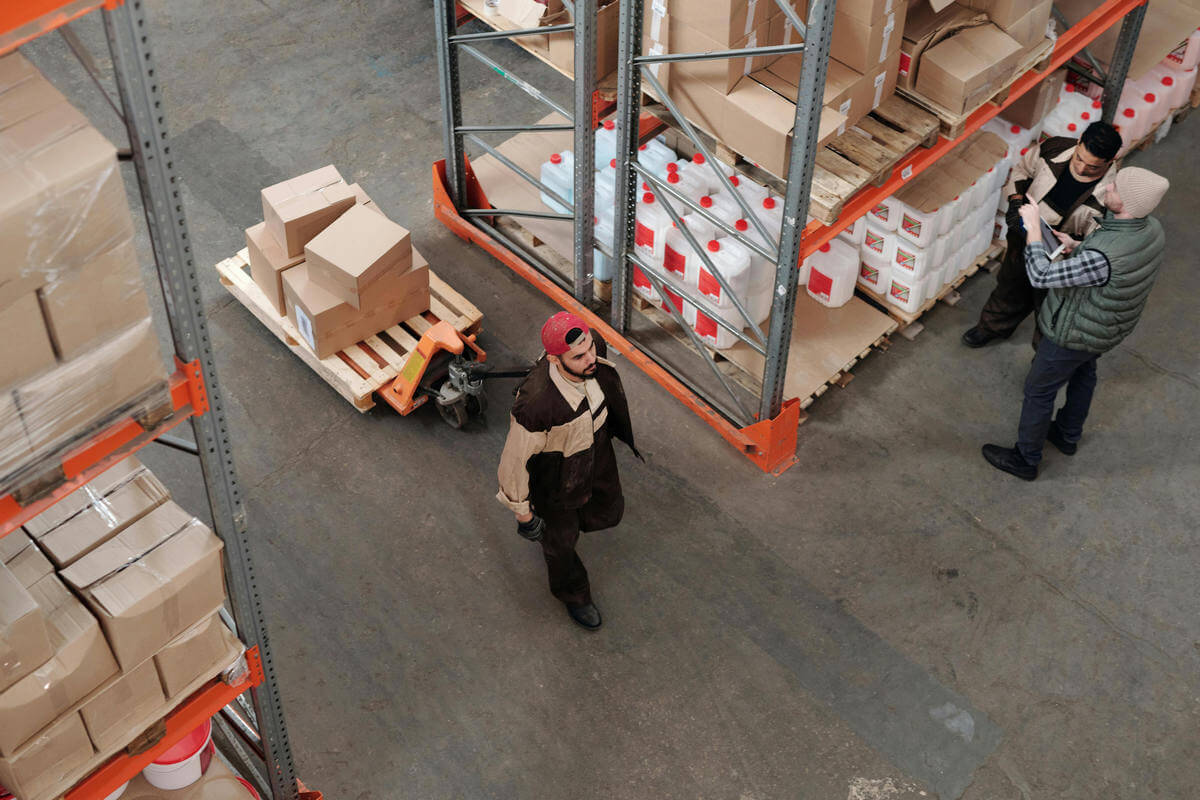
eCommerce order fulfillment is a journey of getting products from your virtual shelves to your customers’ doorstep once they’ve made a purchase. This involves a series of steps:
- Managing and storing inventory
- Processing orders
- Picking the items
- Packing them securely
- Shipping the products
- Handling any returns or exchanges that might arise.
This process can be handled in-house by the eCommerce company themselves or outsourced to a 3rd-party logistics (3PL) provider. eCommerce order fulfillment is a flexible system that caters to both B2B orders, where large quantities head to big-box retailers, and B2C orders, where products are shipped directly to individual shoppers’ homes.
In the case of B2C orders, customers can place their orders either on the merchant’s website or through an online marketplace. Once the customer completes their purchase, that’s when the eCommerce order fulfillment process swings into action.
=> You might like: What is awaiting fulfillment? Why should retailers care about it?
How does fulfillment work?
The way order fulfillment eCommerce unfolds varies based on the type of strategy you employ. For a quick overview, let’s break down the order fulfillment process commonly seen in eCommerce:
#Step 1 — Receiving inventory: You get your stock from suppliers and keep it in a warehouse, stockroom, or storage facility.
#Step 2 — Customer places order: A customer places an order through your eCommerce store.
#Step 3 — Order details received: Your fulfillment team gets the order specifics.
#Step 4 — Picking and packing: The team selects and packs the order, complete with a shipping label and returns form.
#Step 5 — Shipping to customers: The parcel is shipped to the customer’s address.
#Step 6 — Handling returns: In case of a return, the customer uses the returns label to send the parcel back to the warehouse. Here, the fulfillment team inspects the product and processes a return if it meets the return policies.
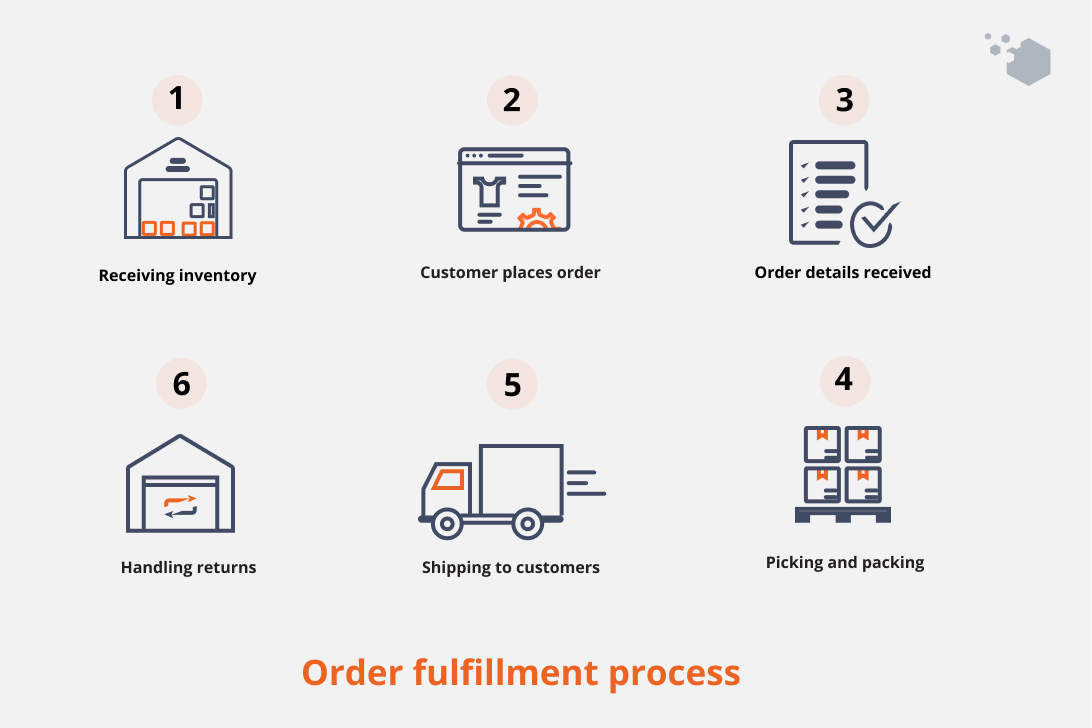
Why order fulfillment is important?
While order fulfillment eCommerce might not grab the spotlight, it’s a function directly influencing an online merchant’s financial success. In fact, the impact of order fulfillment extends to customer satisfaction, loyalty, and retention, making it a linchpin for eCommerce triumph.
To underscore this, let’s delve into some statistics highlighting the pivotal role and challenges of eCommerce fulfillment in today’s market:
- 24% of shoppers have canceled an order due to slow delivery speeds.
- 48% of shoppers will abandon their carts if they find shipping, taxes, or other fees too high.
- 69% of customers are likely to stop shopping from a retailer if the order doesn’t arrive within two days of the promised delivery date.
- 85% of shoppers decide never to return to a retailer after a poor delivery experience.
As you can see, these statistics underscore the considerable expectations and limited tolerance customers have for eCommerce fulfillment. Therefore, every business should select the right fulfillment strategy for their online store to maintain competitiveness and profitability in the eCommerce industry.
Still, choosing the best fulfillment strategy for your business is NOT an easy task. It really depends on various factors, such as your business size, product type, order volume, customer demand, budget, etc. You may need to consider different fulfillment options, which we’ll have an in-depth guide on below.
What are the 3 types of fulfillment?
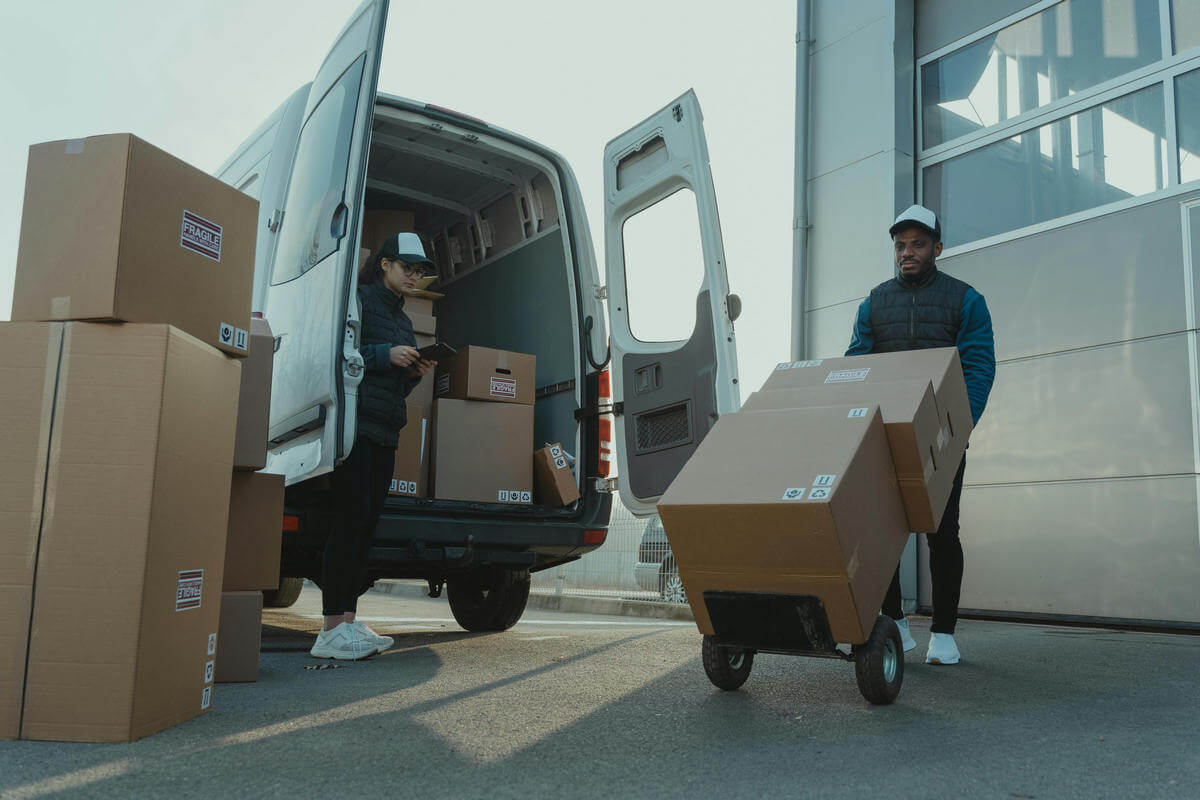
the grand scheme of the supply chain, eCommerce order fulfillment is a key player, as it holds a pivotal role in the entire process. eCommerce order fulfillment has 3 main types that every merchant should know: Self-fulfillment, Dropshipping, and Third-party logistics (3PL).
These types cater to distinct business needs, each having its own set of advantages and drawbacks. Let’s take a closer look to paint a comprehensive picture of these fulfillment methods.
1. Self-fulfillment
Self-fulfillment is when an online seller manages the entire fulfillment process independently without relying on a third-party logistics (3PL) provider. This entails overseeing inventory, processing and picking orders, packing and shipping products, and handling returns and exchanges.
While self-fulfillment can be cost-effective and offer more control and flexibility to the seller, it demands additional time, space, and resources. Besides, eCommerce businesses often adopt this approach in their early stages or those with lower order volumes.
However, as the business expands and order volumes rise, self-fulfillment can become cumbersome and inefficient. Sellers may need to explore other fulfillment options to ensure continued growth and operational efficiency.
Pros and cons:
Pros | Cons |
|
|
Self-fulfillment works well for:
- New or low-volume businesses aim to save costs and avoid extra fees.
- Businesses with unique products want more control over inventory and shipping.
- Brands prioritize quality and consistency in their fulfillment process.
2. Dropshipping
In eCommerce fulfillment, dropshipping is a method of selling products online without the hassle of storing, packing, or shipping them yourself. Instead, you collaborate with a supplier responsible for inventory and fulfillment.
When a customer places an order, you relay the details to the supplier, who then ships the product directly to the customer. This eliminates concerns about managing an eCommerce warehouse fulfillment, packaging materials, or handling shipping costs. As a result, you can concentrate 100% on marketing and expanding your online store.
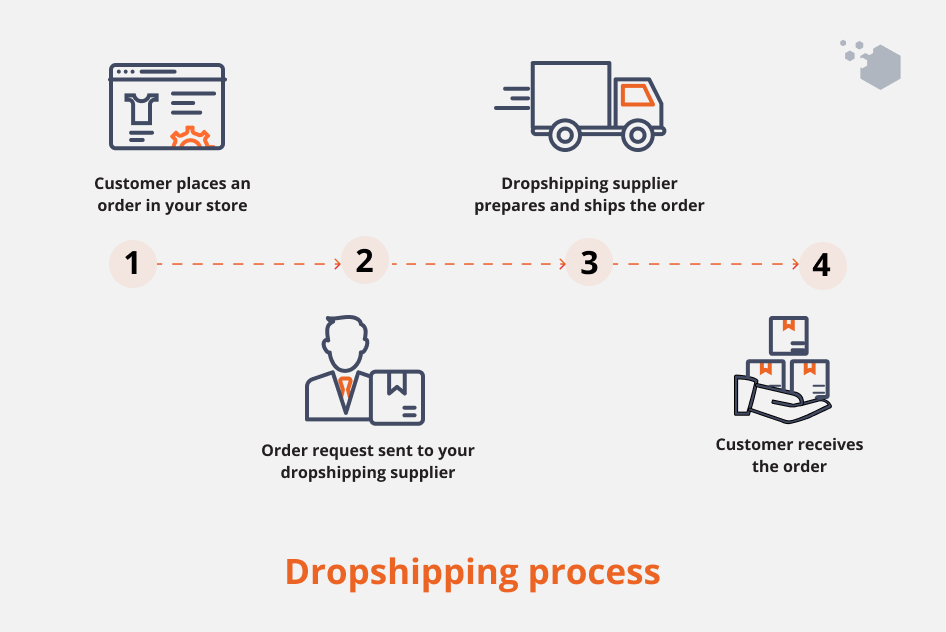
But for that all, these dropshipping eCommerce fulfillment companies aren’t the ideal choice if speedy delivery is crucial. Why? Because it provides minimal control over the supply process, hindering your ability to track orders or assist customers with their orders. Furthermore, the distance between merchants and delivery locations can impact the eCommerce order fulfillment cycle time.
Pros and cons:
Pros | Cons |
|
|
Dropshipping is suitable for you to:
- Target a specific market effectively with clear marketing strategies
- Work with a trusted supplier for quality products, fast shipping, and good communication
- Possess a strong brand identity to attract loyal customers
- Adapt well to uncertainty, change, and risk
=> Read more: What is curbside pickup and how does it work?
3. Third-party logistics (3PL)
Third-party logistics (3PL) involves outsourcing some or all of your logistics and supply chain management tasks to an external service provider. A 3PL provider offers services like warehousing, transportation, inventory management, and order fulfillment tailored to your business needs.
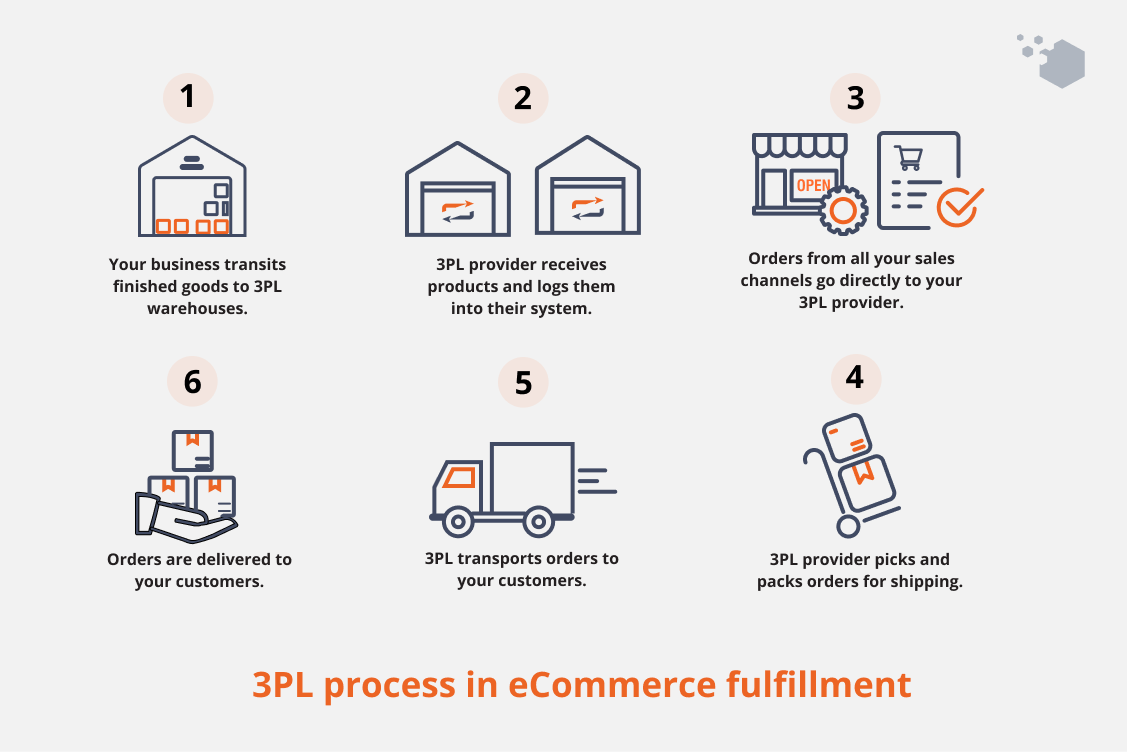
Not to mention, collaborating with 3PL eCommerce fulfillment providers lets you tap into their expertise, technology, network, and resources. Then, of course, you can focus on core aspects like product development, marketing, and customer service (similar to dropshipping in this regard).
Still, there are potential challenges and drawbacks to consider with 3PL. These include:
- Relinquishing control over operations, quality, and delivery time
- Navigating communication and coordination issues
- Encountering higher costs and fees, such as storage, pick and pack, shipping, and even returns
- Adhering to diverse regulations and standards
Therefore, a thorough evaluation of your business needs, goals, and expectations is crucial. Also, merchants need to carefully choose a 3PL provider aligned with requirements to facilitate the growth of their eCommerce business.
Pros and cons:
Pros | Cons |
|
|
3PL is beneficial for:
- Large or high-volume businesses that want to save time and resources and focus on their core competencies.
- Businesses sell standard products without needing customization or quality control.
- Brands scaling and expanding into new markets for faster, cost-effective delivery.
On the sidelines: There might be some questions as to why we haven’t included “hybrid fulfillment” as a distinct option on our list. The reason is pretty straightforward — hybrid fulfillment is not a standalone category like the others. Instead, it’s a blend of various fulfillment methods.
When we talk about hybrid fulfillment, we’re referring to a strategy that combines different approaches. In simpler terms, hybrid fulfillment is a flexible approach that lets online sellers mix and match to get the best results.
For example, an online clothing store may use in-house fulfillment for their best-selling items, dropshipping for custom or made-to-order products, and 3PL for international orders to reduce shipping times and costs. The beauty of hybrid fulfillment lies in its ability to help sellers cut costs, be more adaptable, and enhance overall customer satisfaction.
How to choose a suitable fulfillment model for your business
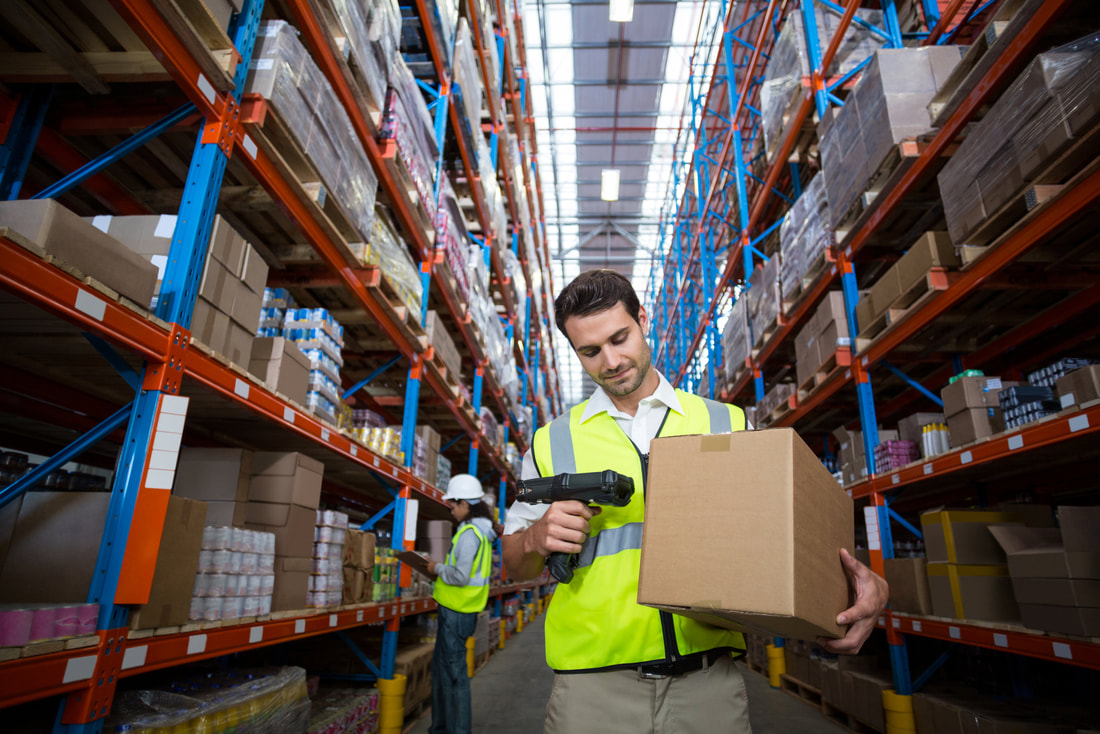
When it comes to order fulfillment in eCommerce, it’s crucial to take a good look at what your business really needs before deciding on (or switching up) your fulfillment approach. Check out these six key areas — it’s not just about picking what works best right now but also about choosing something that can keep up with your business growth.
1. Business size
The number and frequency of your orders hinge on your business size. For a big online store with lots of products and high demand, handling orders at home might not work. You might need more staff, extra gear, or help from a third-party service. But if your online store is small, with a few products and not much demand, doing it yourself at home could be a good and cost-saving way to begin.
2. Product type
What you’re selling really matters when it comes to how you get things to your customers. Is it a raw material or a finished product? Can people order it right from you, or is it something you buy from suppliers and then sell to individuals? Figuring out these details helps you decide what kind of eCommerce warehouse fulfillment, timing, packing stuff, and particular setup you need to handle your orders.
For example:
- If you sell big, heavy, or delicate items like furniture, appliances, or glassware, you’ll likely need more space, equipment, and packaging. Shipping costs and times may also be higher. Then, merchants should consider using 3PL or hybrid fulfillment for these products.
- For small, light, or durable items like books or clothing, handling them on your own might be more cost-effective. You can manage shipping more efficiently and offer faster, cheaper options. In such cases, self-fulfillment or dropshipping could be suitable for your businesses.
3. Sales channels
Your sales channels are the platforms or places where you sell products, such as your own website, online marketplaces, social media, or brick-and-mortar stores. Each of these channels might have different requirements and expectations from your delivery process, such as the speed, cost, tracking, and packaging of your orders. Therefore, when picking a fulfillment model, you need to consider the following factors:
- First, look at how many channels you’re on. Are you just online, offline, or both? Do you need to connect your inventory and orders across them?
- Then, think about the people buying from each place. Who are they? What do they want when it comes to shipping — is speed important, or is cost more of a big deal? Do they care about tracking and how the package looks?
- Lastly, check out what each channel can and can’t do. What are their rules? How does it affect your revenue, what you have in stock, and how happy your customers are? Can they grow with your business?
Once you figure all this out, you can pick a way to handle orders that work with your sales platforms.
- Self-fulfillment: Good for small businesses with just one channel or not many orders
- Third-party fulfillment: This works if you use many channels or have lots of orders like using Fulfillment by Amazon.
- Dropshipping: If you sell unique or custom things or want to try new markets, this could be a good fit.

4. Supply level tracking
Now, let’s think about how often you want to update your inventory. You want an eCommerce fulfillment model that gives you real-time or nearly real-time info on what you have in stock across different channels and places.
- If you use 3PLs, make sure they can sync up with your platform.
- If you do it yourself, invest in reliable inventory software that can sync and centralize all order data across sales channels and warehouses and let you implement eCommerce fulfillment automation for high efficiency.
How easy to access and view your data. We all want a model that lets us quickly check the quantity, location, status, and history of the products. This helps us make data-backed decisions about when to restock, where to put things, and how to enhance our inventory work.
- In this case, if you use dropshipping, remember to keep things clear with your suppliers about what they have in stock and how long it takes.
- If you leverage hybrid fulfillment, having a dashboard that shows your inventory levels in one place is a must.
How well can your inventory control adapt to your business development? Your model should handle shifts in your stock needs, like busy seasons, new products, promotions, and growth. This means you keep things moving and avoid having stuff sit around too long.
- When using an eCommerce fulfillment center, confirm their capacity to manage your growing stock.
- For in-store order handling, make sure you have enough staff and equipment to process and ship orders effectively.
5. Shipping speeds
As Amazon’s two-day delivery becomes the norm in the industry, picking an eCommerce fulfillment service for your online business means finding one that can swiftly deliver your products to customers.
If your delivery takes too long, your customers might head to your competitors, and that’s not good for business. With everyone aiming for faster deliveries like next-day or same-day, you should take a serious look at this point to move at the speed of your customers.
6. Location
Where you choose to fulfill orders is a big deal. It decides if you can keep up with what your customers expect and ship stuff on time. Plus, it plays a vital role in how much shipping costs and if it’s doable for your customers.
The smart move is to set up your fulfillment spot near your customers. Aim for a place where you can promise one- or two-day shipping to lots of city areas, where there are plenty of carriers and ways to get things around. If you don’t plan to operate a warehouse yourself, the 3PL method excels in such a case.
Simplify eCommerce fulfillment process with Magestore
As we all know, order fulfillment in eCommerce is a crucial part of any retail business. It helps shape how customers view your service and impacts your bottom line. Not to mention, you also need to ensure that your products are delivered to your customers quickly, correctly, and cost-effectively.
But let’s be honest: managing fulfillment can get tricky, especially when you have to deal with multiple sales channels, eCommerce fulfillment warehouses, and delivery services.
📌That’s why you need a reliable tool like Magestore Order Fulfillment to automate and streamline the whole process, making it faster and more accurate, from checking to shipping orders.
This solution is all about making your life as an eCommerce merchant a whole lot easier! And thanks to Magestore, you can:
- Automate the fulfillment process in 5 easy-peasy steps: Verify, Fulfill, Pick, Pack, and Deliver
- Keep tabs on your items with barcode scanning — accuracy, check!
- Filter orders by status, batch, and tag — finding stuff made simple
- View performance reports by staff and location anytime — data-driven decisions, anyone?
- Manage order fulfillment from one central hub — less chaos, more control
- Speedy order location with live view and visual charts — because time is money
- Optimize the process with 4 insightful reports — data is power
- Run all your daily fulfillment operations fast and conveniently with Retail Management PWA
At our core, Magestore order fulfillment helps you ensure the accuracy and speed of your order fulfillment, reduce human mistakes, save time and effort, and boost customer satisfaction. Moreover, if you’re a Magento merchant, you can rest assured that our top-notch Magento experts will greatly assist you throughout the project. Thus, Magestore’s solution is perfect for any small to large-sized warehouse.
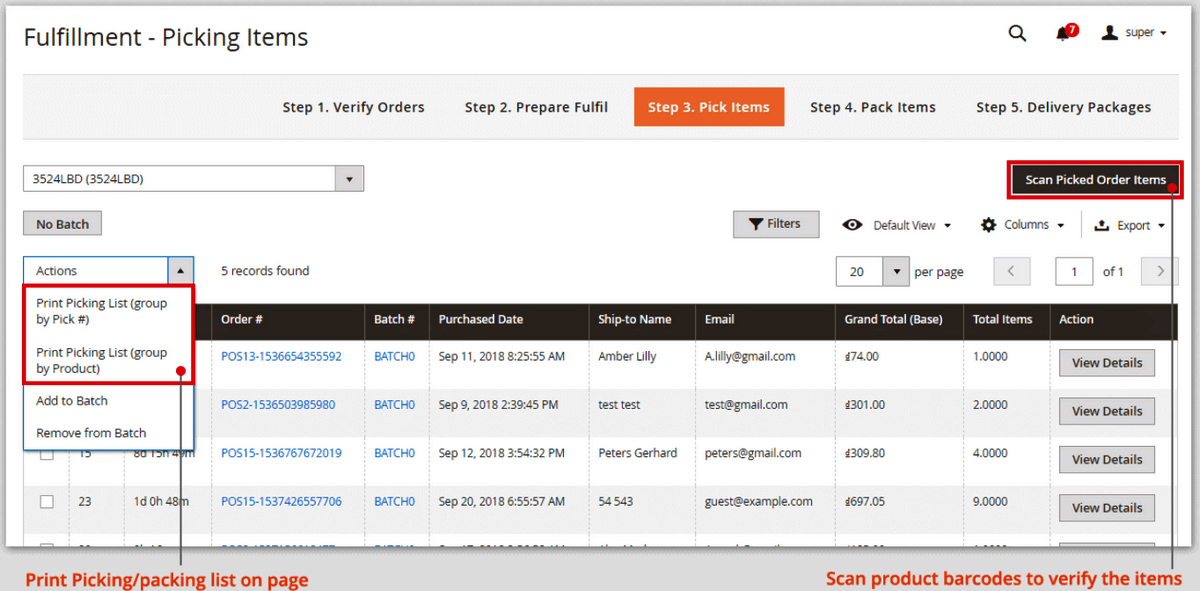
In our Magento Order Management module, handling orders is a breeze. You can easily shoot out a fulfillment request to multiple warehouses for a single order. It’s a bit different in other order management systems, where the store manager can only ping one eCommerce fulfillment warehouse with one request each time.
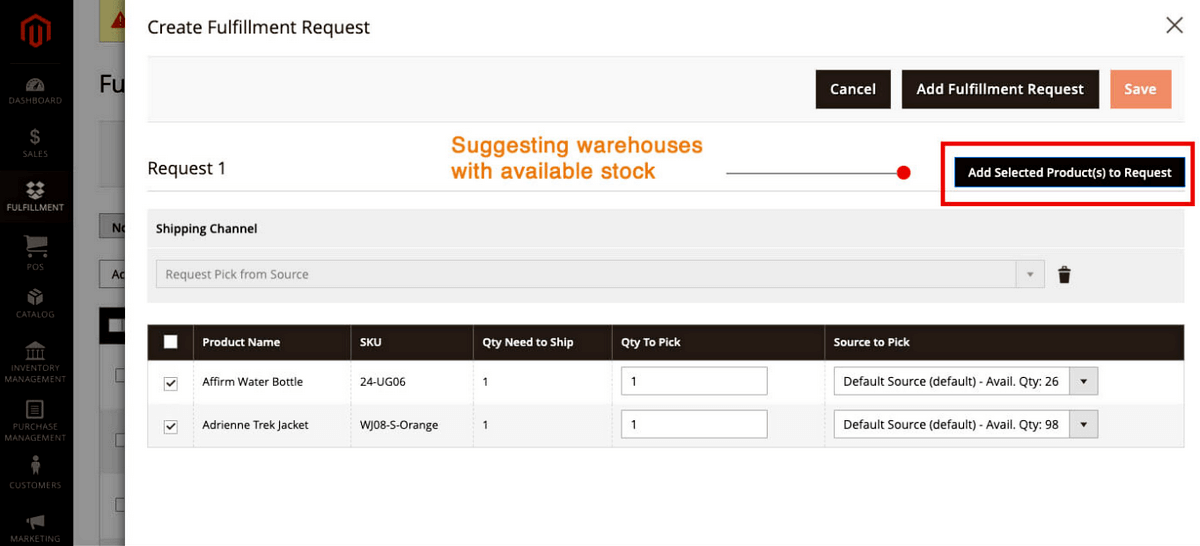
This means if an order has items sitting in two different warehouses, you’d normally have to hit that send button twice. But with Magestore Order Management software, just one request does the trick.
Moreover, to save you some precious time, our software goes the extra mile by suggesting the best eCommerce warehouse fulfillment with the goods ready to roll for shipping.
There have been more than 10,000 customers across the globe who trust and partner with Magestore to grow their business. The next successful merchant will be you.
FAQs
Why is fulfillment important in eCommerce?
Order fulfillment in eCommerce is important for businesses because it makes sure customers get their orders quickly and as they expect. When orders are handled accurately and promptly, it boosts customer satisfaction and loyalty. This, in turn, results in repeat purchases and positive word of mouth.
What do eCommerce fulfillment services cost?
The cost of eCommerce fulfillment service depends on various factors, such as the type and volume of products, the number of orders, the location of the warehouses, the speed of delivery, and the level of service.
Here are the usual eCommerce fulfillment pricing lists you might face:
Receiving in the warehouse:
- Hourly: $20 – $50.
- Per-item: $5 – $15 per pallet or $0.25 per item
Storing and managing inventory:
- Pallet: $10 – $15 monthly
- Cubic foot: $0.45 – $0.55 monthly
Picking and packing:
- Per order: $2.50 – $5.00
- Per item: $0.20 – $1.00
- Per box: $0.50 – $1.50
Packaging:
- Standard: $0.75 – $1.00 per order
- Custom: Varies by design
eCommerce order fulfillment shipping:
- $5.00 – $10.00 per order, with carrier discounts possible
Handling returns:
- $3.00 – $5.00 per order
What is the difference between eCommerce and fulfillment?
The main difference between eCommerce and fulfillment is:
- eCommerce handles the frontend. This process involves selling through online platforms like websites or apps.
- Fulfillment, on the other hand, manages the backend, which ensures the delivery of products or services to customers after they make online orders.













